Improve the Simulation of Radiation Interception and Distribution of the Strip-Intercropping System by Considering the Geometric Light Transmission
Abstract
1. Introduction
2. Materials and Methods
2.1. Model Theory
2.1.1. Horizontally Homogeneous Canopy Model (HHC Model)
2.1.2. Gou Fang Model (GF Model)
2.1.3. Daily Radiation Transmission Model (DRT Model)
2.2. Experimental Data Collection
2.3. Statistical Indicators
3. Results
3.1. Model Evaluation in Experiment A
3.1.1. Fraction of Photosynthetically Active Radiation Interception
3.1.2. Simulated Spatiotemporal Photosynthetically Active Radiation Interception in the DRT Model
3.2. Model Evaluation in Experiment B
3.2.1. Fraction of Photosynthetically Active Radiation Interception
3.2.2. Simulated Spatiotemporal Photosynthetically Active Radiation Interception in the DRT Model
4. Discussion
4.1. The Factors Contributing to the Performances of the Three Models
4.2. The Spatial Daily Radiation Interception of the DRT Model
5. Conclusions
Author Contributions
Funding
Data Availability Statement
Conflicts of Interest
Appendix A
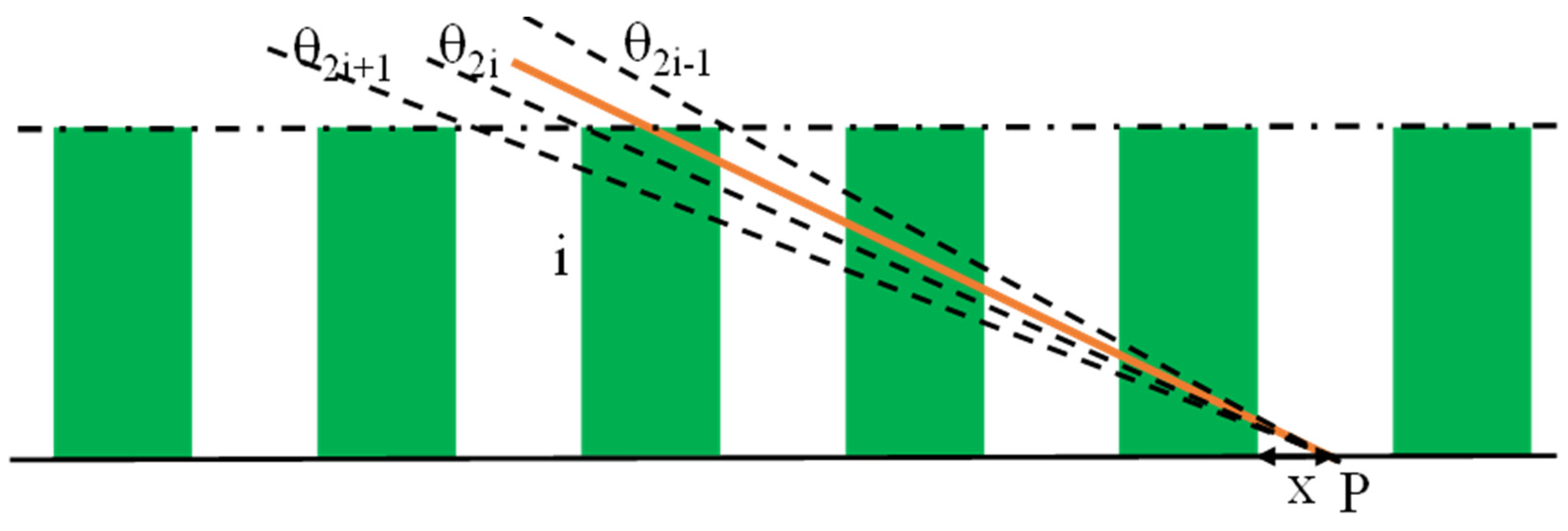
Appendix B


Appendix C
References
- Mao, L.L.; Zhang, L.Z.; Zhang, S.P.; Evers, J.B.; van der Werf, W.; Wang, J.J.; Sun, H.Q.; Su, Z.C.; Spiertz, H. Resource use efficiency, ecological intensification and sustainability of intercropping systems. J. Integr. Agric. 2015, 14, 1542–1550. [Google Scholar] [CrossRef]
- Wu, Y.S.; He, D.; Wang, E.L.; Liu, X.; Huth, N.I.; Zhao, Z.G.; Gong, W.Z.; Yang, F.; Wang, X.C.; Yong, T.W.; et al. Modelling soybean and maize growth and grain yield in strip intercropping systems with different row configurations. Field Crop. Res. 2021, 265, 108122. [Google Scholar] [CrossRef]
- Du, J.B.; Han, T.F.; Gai, J.Y.; Yong, T.W.; Sun, X.; Wang, X.C.; Yang, F.; Liu, J.; Shu, K.; Liu, W.G.; et al. Maize-soybean strip intercropping: Achieved a balance between high productivity and sustainability. J. Integr. Agric. 2018, 17, 747–754. [Google Scholar] [CrossRef]
- Yang, F.; Liao, D.P.; Wu, X.L.; Gao, R.C.; Fan, Y.F.; Raza, M.A.; Wang, X.C.; Yong, T.W.; Liu, W.G.; Liu, J.; et al. Effect of aboveground and belowground interactions on the intercrop yields in maize-soybean relay intercropping systems. Field Crops Res. 2017, 203, 16–23. [Google Scholar] [CrossRef]
- Lemeur, R.; Blad, B.L. A critical review of light models for estimating the shortwave radiation regime of plant canopies. Agric. Meteorol. 1974, 14, 255–286. [Google Scholar] [CrossRef]
- Nilson, T. Radiative Transfer in Nonhomogeneous Plant Canopies. In Advances in Bioclimatology 1; Desjardins, R.L., Gifford, R.M., Nilson, T., Greenwood, E.A.N., Eds.; Springer: Berlin/Heidelberg, Germany, 1992; pp. 59–88. [Google Scholar]
- Wang, Z.; Zhao, X.; Wu, P.; Gao, Y.; Yang, Q.; Shen, Y. Border row effects on light interception in wheat/maize strip intercropping systems. Field Crops Res. 2017, 214, 1–13. [Google Scholar] [CrossRef]
- Liu, H.T.; Chen, S.H.; Li, B.G.; Guo, S.; Tian, J.; Yao, L.; Lin, C.W. The effect of strip orientation and width on radiation interception in maize-soybean strip intercropping systems. Food Energy Secur. 2022, 11, e364. [Google Scholar] [CrossRef]
- Gijzen, H.; Goudriaan, J. A flexible and explanatory model of light-distribution and photosynthesis in row crops. Agric. For. Meteorol. 1989, 48, 1–20. [Google Scholar] [CrossRef]
- Tsubo, M.; Walker, S. A model of radiation interception and use by a maize-bean intercrop canopy. Agric. For. Meteorol. 2002, 110, 203–215. [Google Scholar] [CrossRef]
- Munz, S.; Graeff-Honninger, S.; Lizaso, J.I.; Chen, Q.; Claupein, W. Modeling light availability for a subordinate crop within a strip-intercropping system. Field Crop. Res. 2014, 155, 77–89. [Google Scholar] [CrossRef]
- Wang, Z.K.; Cao, Q.; Shen, Y.Y. Modeling light availability for crop strips planted within apple orchard. Agric. Syst. 2019, 170, 28–38. [Google Scholar] [CrossRef]
- OzierLafontaine, H.; Vercambre, G.; Tournebize, R. Radiation and transpiration partitioning in a maize-sorghum intercrop: Test and evaluation of two models. Field Crops Res. 1997, 49, 127–145. [Google Scholar] [CrossRef]
- Goudriaan, J. Crop Micrometeorology: A Simulation Study; Wageningen University and Research: Wageningen, The Netherlands, 1977. [Google Scholar]
- Pronk, A.A.; Goudriaan, J.; Stilma, E.; Challa, H. A simple method to estimate radiation interception by nursery stock conifers: A case study of eastern white cedar. NJAS Wagening. J. Life Sci. 2003, 51, 279–295. [Google Scholar] [CrossRef][Green Version]
- Zhang, L.; van der Werf, W.; Bastiaans, L.; Zhang, S.; Li, B.; Spiertz, J.H.J. Light interception and utilization in relay intercrops of wheat and cotton. Field Crops Res. 2008, 107, 29–42. [Google Scholar] [CrossRef]
- Wang, Z.K.; Zhao, X.N.; Wu, P.T.; He, J.Q.; Chen, X.L.; Gao, Y.; Cao, X.C. Radiation interception and utilization by wheat/maize strip intercropping systems. Agric. For. Meteorol. 2015, 204, 58–66. [Google Scholar] [CrossRef]
- Gou, F.; van Ittersum, M.K.; Simon, E.; Leffelaar, P.A.; van der Putten, P.E.L.; Zhang, L.; van der Werf, W. Intercropping wheat and maize increases total radiation interception and wheat RUE but lowers maize RUE. Eur. J. Agron. 2017, 84, 125–139. [Google Scholar] [CrossRef]
- Berghuijs, H.N.C.; Weih, M.; van der Werf, W.; Karley, A.J.; Adam, E.; Villegas-Fernandez, A.M.; Kiaer, L.P.; Newton, A.C.; Scherber, C.; Tavoletti, S.; et al. Calibrating and testing APSIM for wheat-faba bean pure cultures and intercrops across Europe. Field Crop. Res. 2021, 264, 108088. [Google Scholar] [CrossRef]
- Van Oort, P.A.J.; Gou, F.; Stomph, T.J.; van der Werf, W. Effects of strip width on yields in relay-strip intercropping: A simulation study. Eur. J. Agron. 2020, 112, 125936. [Google Scholar] [CrossRef]
- Gou, F.; van Ittersum, M.K.; van der Werf, W. Simulating potential growth in a relay-strip intercropping system: Model description, calibration and testing. Field Crops Res. 2017, 200, 122–142. [Google Scholar] [CrossRef]
- Pinto, V.M.; van Dam, J.C.; van Lier, Q.D.; Reichardt, K. Intercropping Simulation Using the SWAP Model: Development of a 2×1D Algorithm. Agriculture 2019, 9, 126. [Google Scholar] [CrossRef]
- Pierre, J.F.; Singh, U.; Ruiz-Sánchez, E.; Pavan, W. Development of a Cereal-Legume Intercrop Model for DSSAT Version 4.8. Agriculture 2023, 13, 845. [Google Scholar] [CrossRef]
- Holzworth, D.P.; Huth, N.I.; Devoil, P.G.; Zurcher, E.J.; Herrmann, N.I.; McLean, G.; Chenu, K.; van Oosterom, E.J.; Snow, V.; Murphy, C.; et al. APSIM—Evolution towards a new generation of agricultural systems simulation. Environ. Model. Softw. 2014, 62, 327–350. [Google Scholar] [CrossRef]
- Tsubo, M.; Walker, S.; Ogindo, H.O. A simulation model of cereal–legume intercropping systems for semi-arid regions. Field Crop. Res. 2005, 93, 10–22. [Google Scholar] [CrossRef]
- Gao, Y.; Duan, A.W.; Qiu, X.Q.; Li, X.Q.; Pauline, U.; Sun, J.S.; Wang, H.Z. Modeling evapotranspiration in maize/soybean strip intercropping system with the evaporation and radiation interception by neighboring species model. Agric. Water Manag. 2013, 128, 110–119. [Google Scholar] [CrossRef]
- Li, S.W.; van Der Werf, W.; Zhu, J.Q.; Guo, Y.; Li, B.G.; Ma, Y.T.; Evers, J.B. Estimating the contribution of plant traits to light partitioning in simultaneous maize/soybean intercropping. J. Exp. Bot. 2021, 72, 3630–3646. [Google Scholar] [CrossRef]
- Stewart, D.W.; Costa, C.; Dwyer, L.M.; Smith, D.L.; Hamilton, R.I.; Ma, B.L. Canopy structure, light interception, and photosynthesis in maize. Agron. J. 2003, 95, 1465–1474. [Google Scholar] [CrossRef]
- Goudriaan, J. A simple and fast numerical-method for the computation of daily totals of crop photosynthesis. Agric. For. Meteorol. 1986, 38, 249–254. [Google Scholar] [CrossRef]
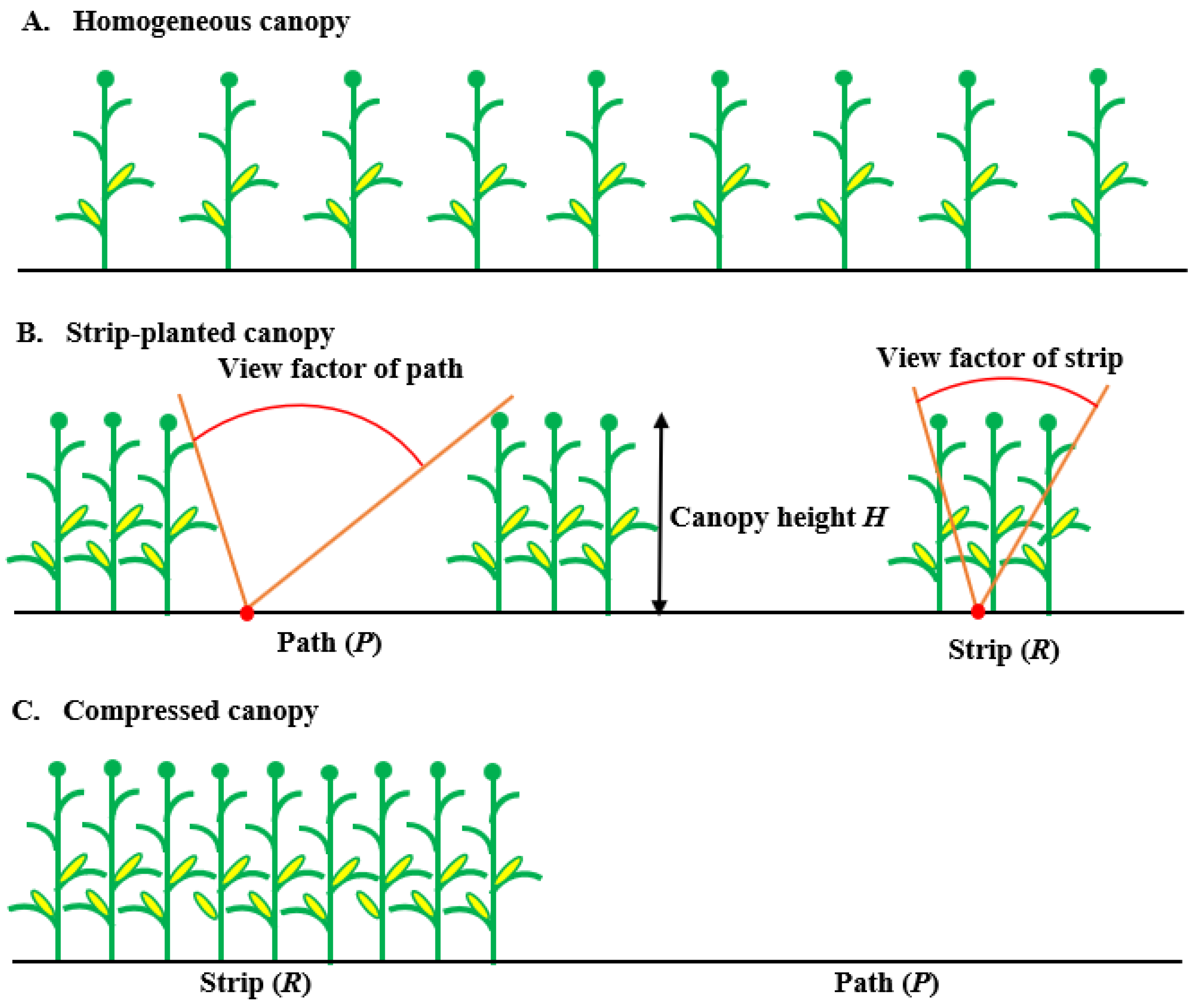
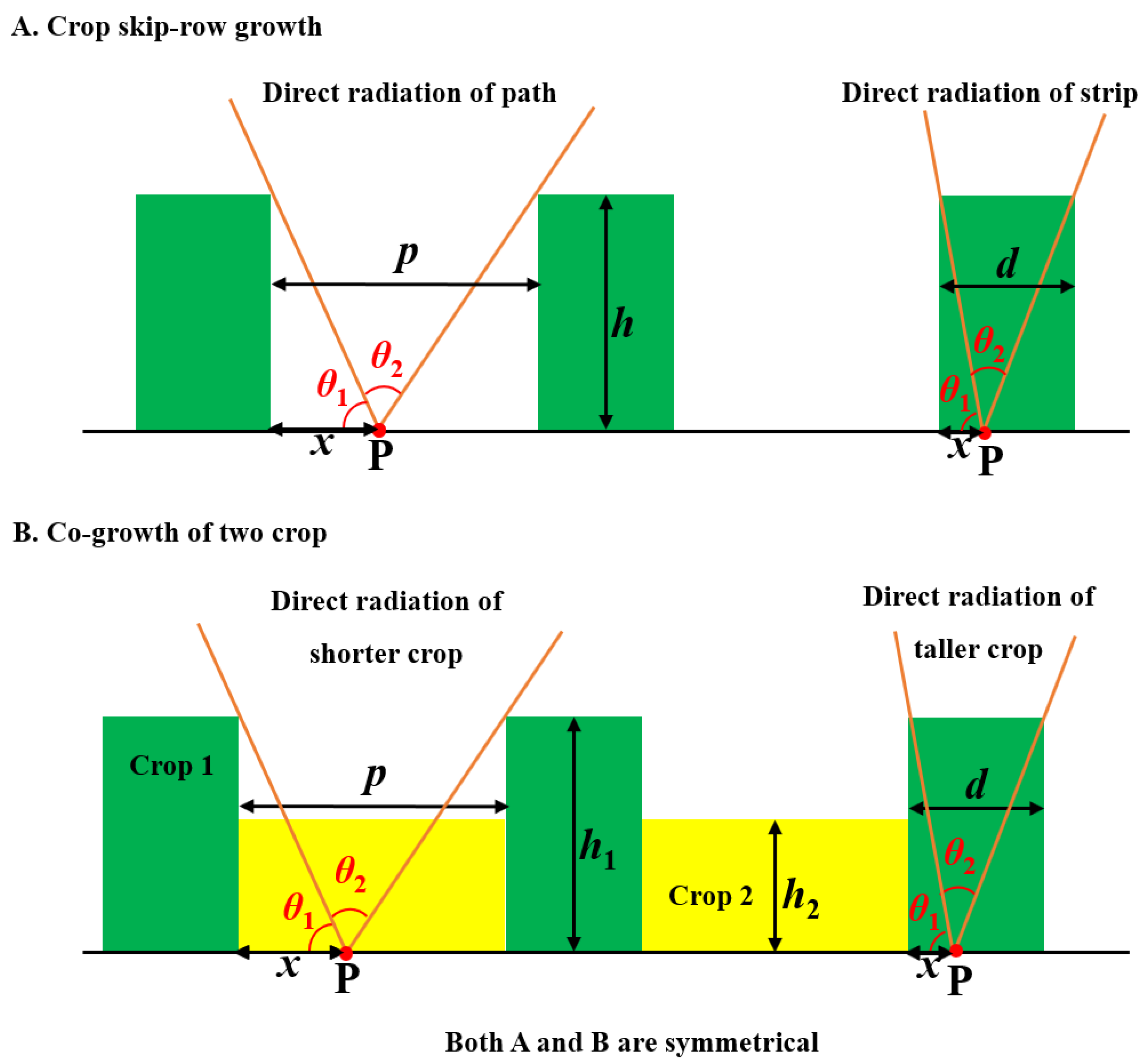
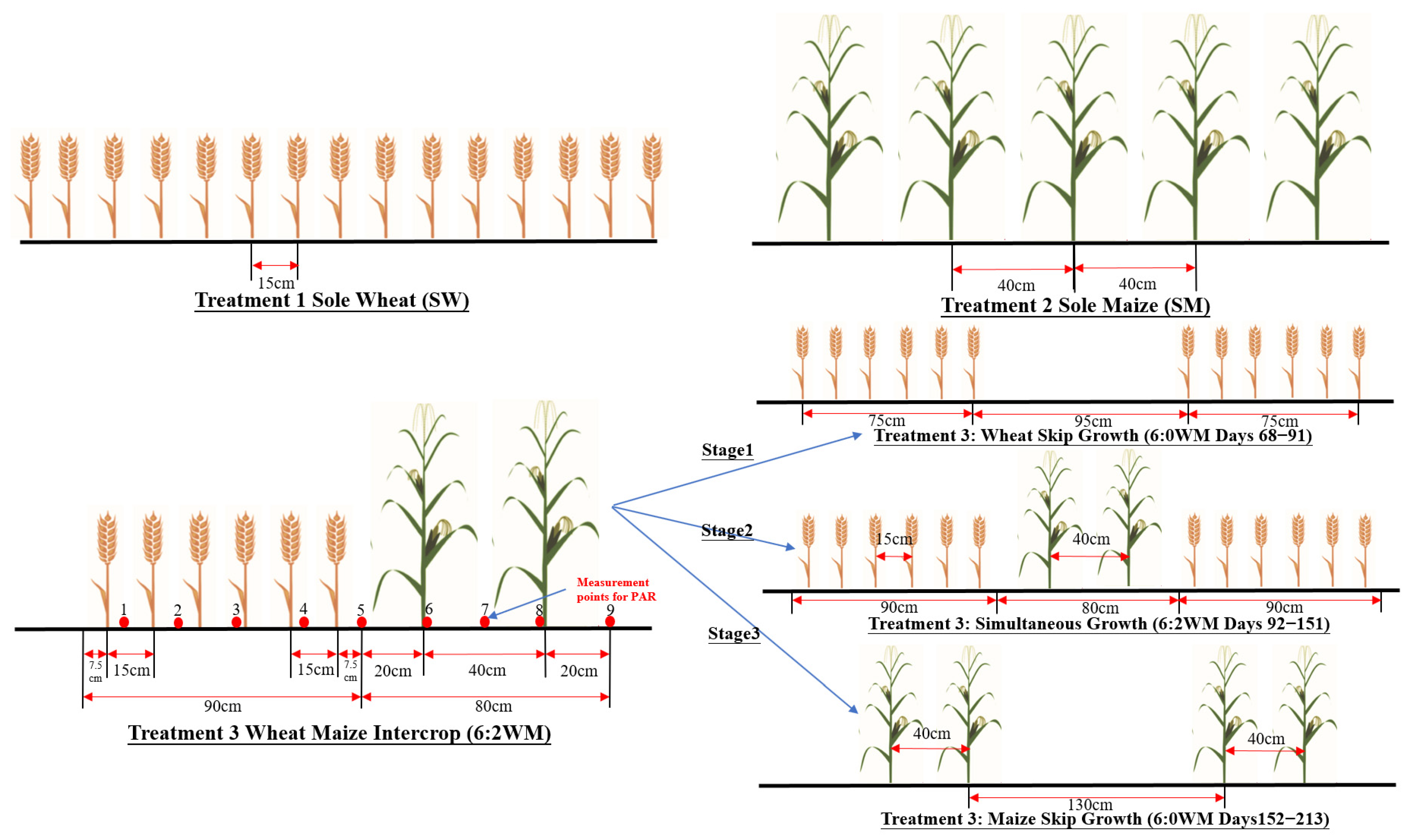

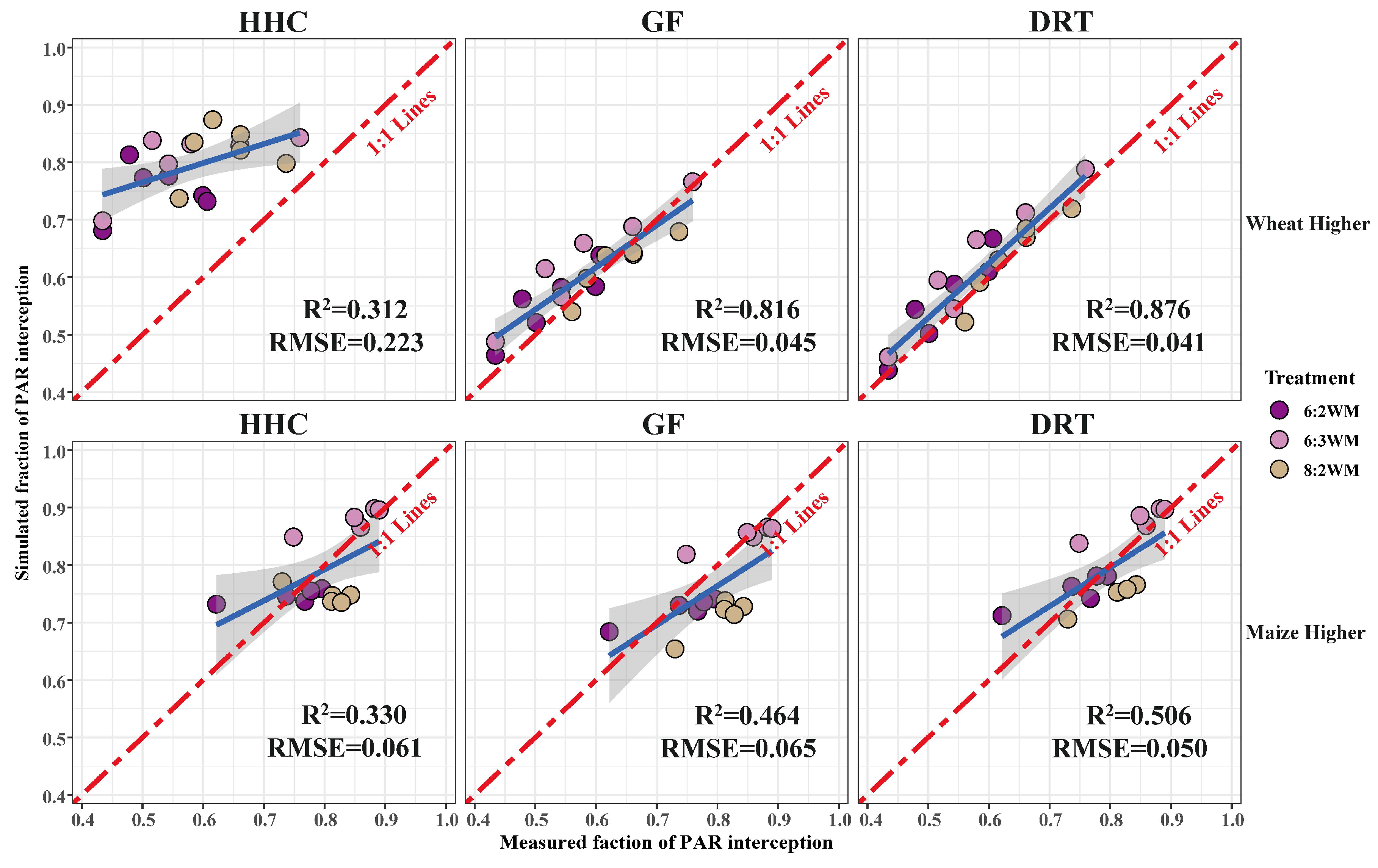
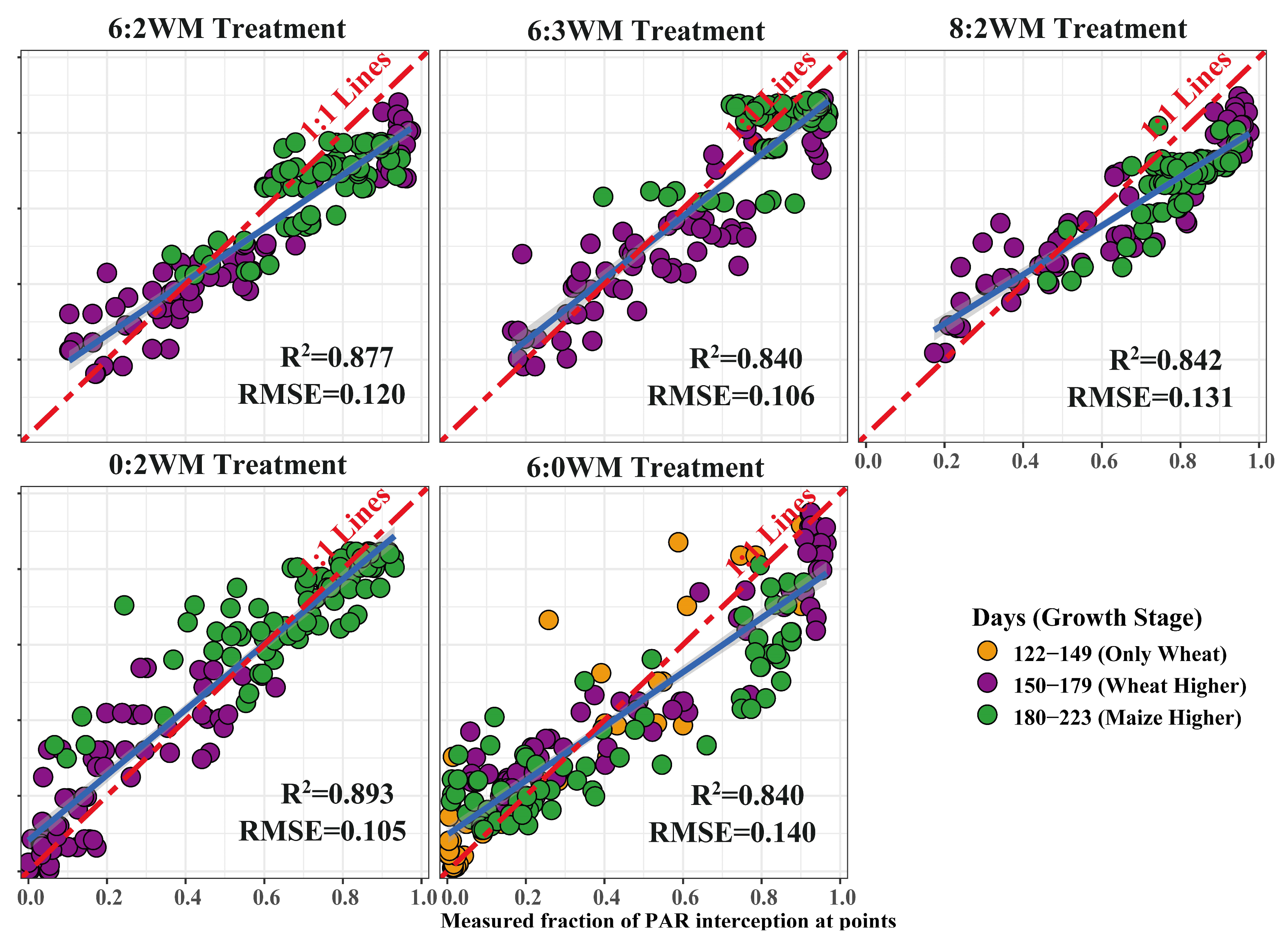
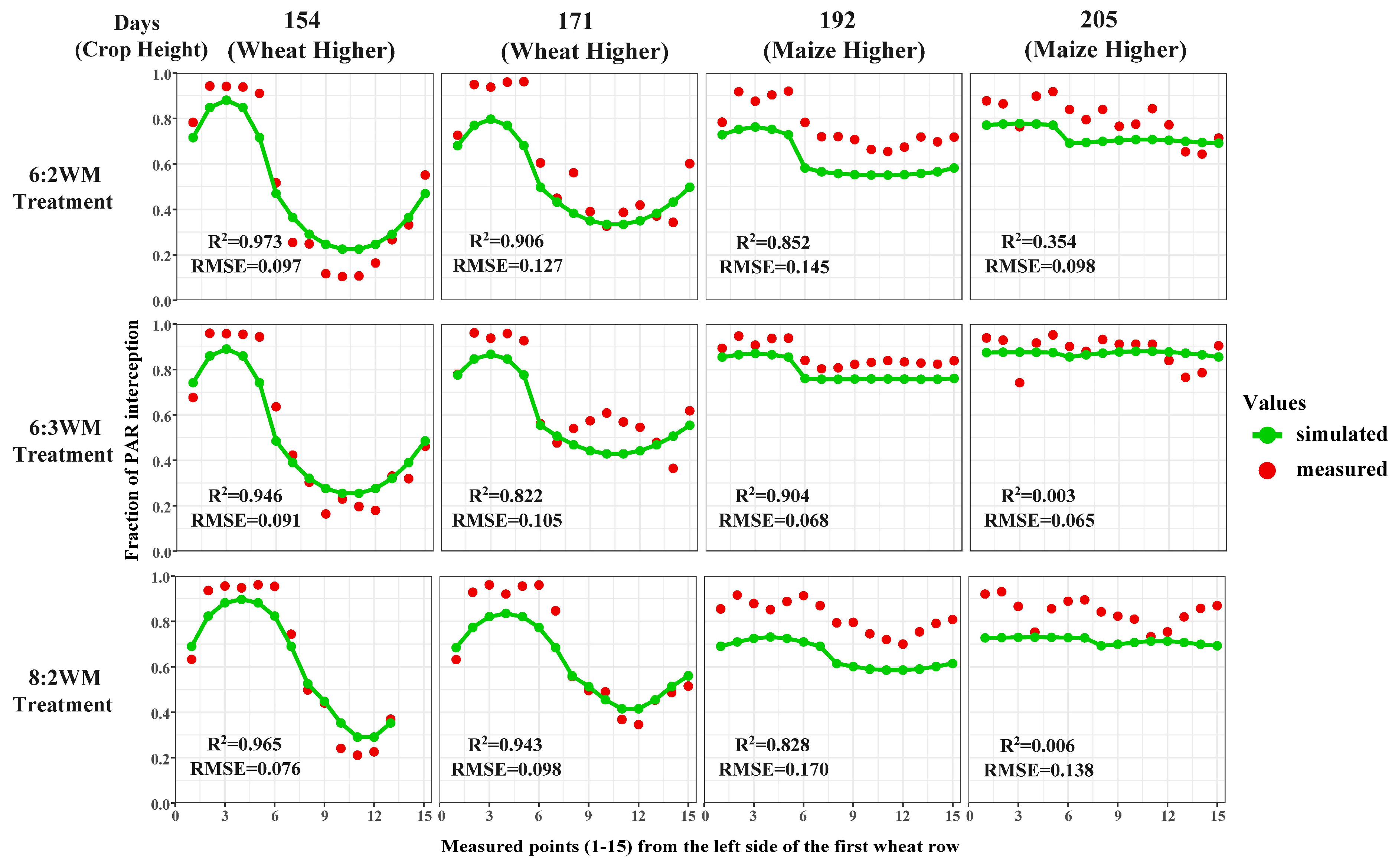

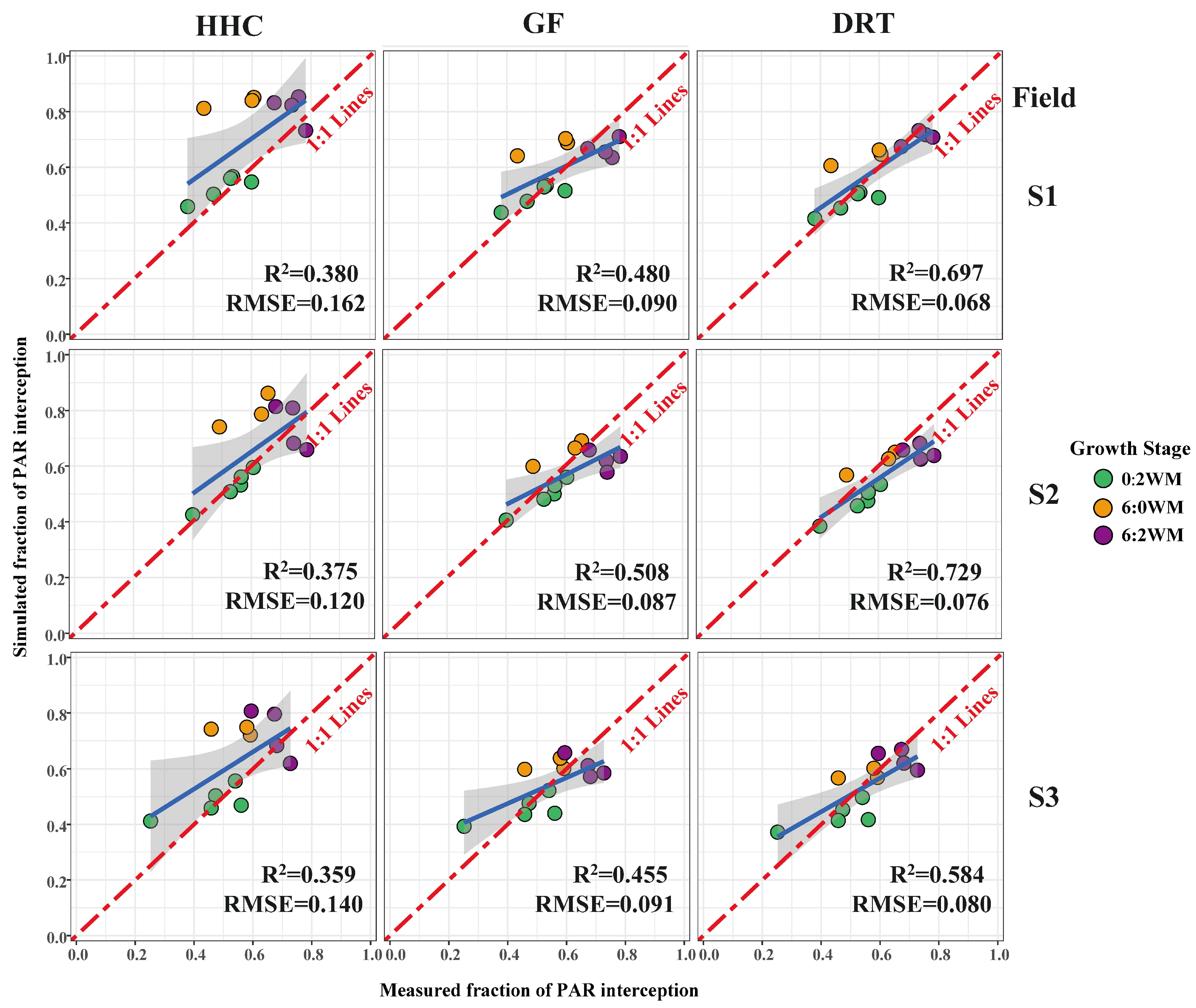

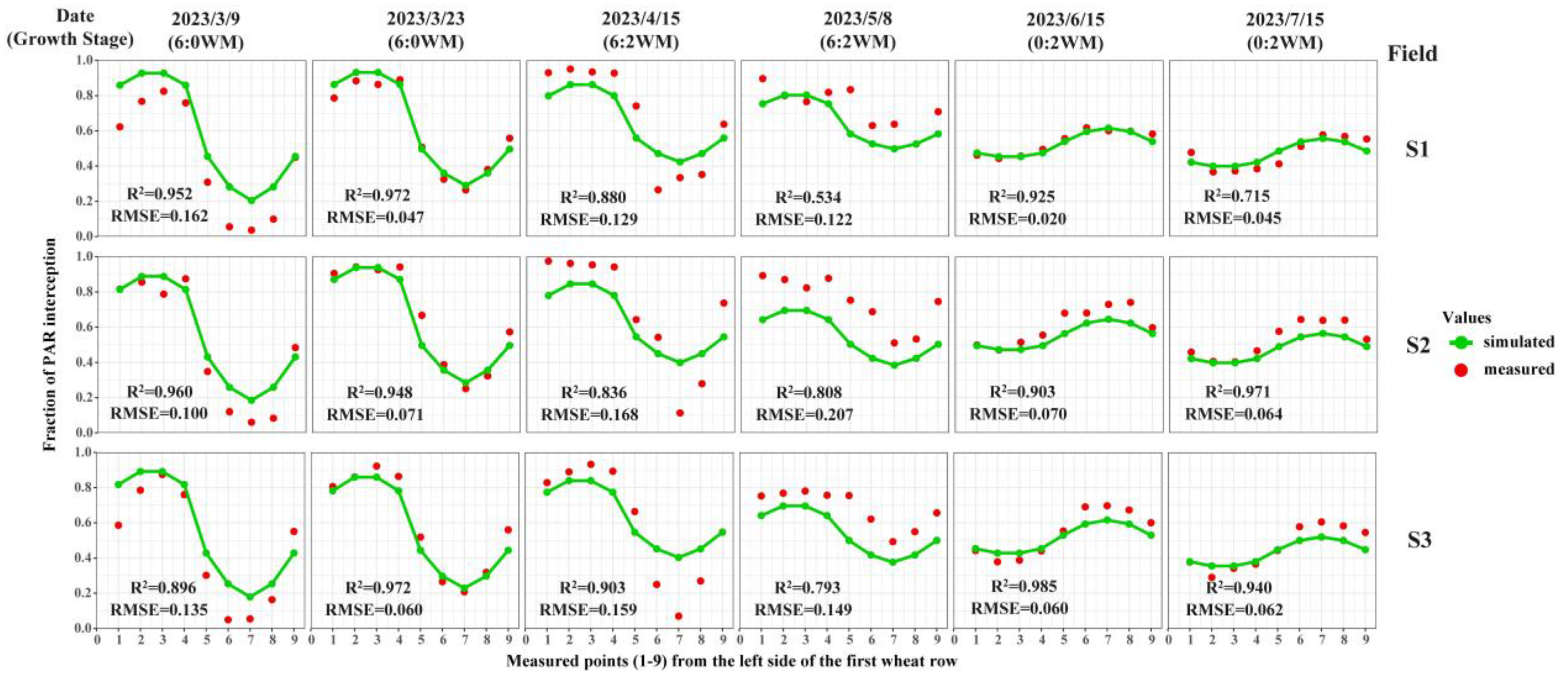
| Treatment | Days | Measured | HHC | GF | DRT |
|---|---|---|---|---|---|
| 0:2 WM | 150 | 0.074 | 0.044 | 0.043 | 0.041 |
| 154 | 0.045 | 0.058 | 0.057 | 0.055 | |
| 164 | 0.173 | 0.236 | 0.226 | 0.219 | |
| 171 | 0.261 | 0.319 | 0.304 | 0.294 | |
| 178 | 0.353 | 0.432 | 0.407 | 0.393 | |
| 184 | 0.437 | 0.608 | 0.566 | 0.544 | |
| 192 | 0.678 | 0.712 | 0.668 | 0.642 | |
| 199 | 0.714 | 0.781 | 0.741 | 0.714 | |
| 205 | 0.791 | 0.812 | 0.773 | 0.746 | |
| 212 | 0.748 | 0.813 | 0.775 | 0.749 | |
| 223 | 0.769 | 0.814 | 0.776 | 0.750 | |
| 223 (6:2 WM) | 0.561 | 0.684 | 0.657 | 0.635 | |
| 223 (6:3 WM) | 0.709 | 0.860 | 0.818 | 0.790 | |
| 223 (8:2 WM) | 0.597 | 0.631 | 0.609 | 0.587 | |
| 6:0 WM | 122 | 0.185 | 0.233 | 0.194 | 0.187 |
| 136 | 0.241 | 0.563 | 0.374 | 0.351 | |
| 143 | 0.434 | 0.698 | 0.448 | 0.414 | |
| 150 | 0.447 | 0.792 | 0.487 | 0.450 | |
| 154 | 0.474 | 0.832 | 0.520 | 0.479 | |
| 164 | 0.467 | 0.785 | 0.539 | 0.495 | |
| 171 | 0.473 | 0.728 | 0.515 | 0.472 | |
| 178 | 0.472 | 0.663 | 0.485 | 0.445 | |
| 184 | 0.349 | 0.614 | 0.460 | 0.422 | |
| 192 | 0.447 | 0.536 | 0.418 | 0.384 | |
| 199 | 0.358 | 0.451 | 0.367 | 0.338 | |
| 205 | 0.396 | 0.393 | 0.328 | 0.304 | |
| 212 | 0.410 | 0.361 | 0.306 | 0.283 | |
| 122 (8:2 WM) | 0.265 | 0.318 | 0.247 | 0.238 | |
| 136 (8:2 WM) | 0.366 | 0.584 | 0.382 | 0.358 | |
| R2 | - | 0.745 | 0.931 | 0.930 | |
| RMSE | - | 0.172 | 0.061 | 0.053 |
| Treatment | Crop Height | d (cm) | p (cm) |
|---|---|---|---|
| 0:2 WM | Maize skip-row | 150 | 75 |
| 6:0 WM | Wheat skip-row | 75 | 150 |
| 6:2 WM | W higher M | 75 | 150 |
| M higher W | 150 | 75 | |
| 6:3 WM | W higher M | 75 | 150 |
| M higher W | 150 | 75 | |
| 8:2 WM | W higher M | 100 | 125 |
| M higher W | 125 | 100 |
| Crop Height | Treatment | Days | Measured | HHC | GF | DRT |
|---|---|---|---|---|---|---|
| W higher M | 6:2 WM | 143 | 0.434 | 0.681 | 0.464 | 0.438 |
| 150 | 0.501 | 0.773 | 0.521 | 0.502 | ||
| 154 | 0.478 | 0.813 | 0.562 | 0.544 | ||
| 164 | 0.543 | 0.776 | 0.582 | 0.588 | ||
| 171 | 0.599 | 0.742 | 0.584 | 0.610 | ||
| 178 | 0.606 | 0.732 | 0.638 | 0.667 | ||
| 6:3 WM | 143 | 0.434 | 0.698 | 0.488 | 0.461 | |
| 150 | 0.543 | 0.797 | 0.566 | 0.545 | ||
| 154 | 0.516 | 0.838 | 0.615 | 0.595 | ||
| 164 | 0.579 | 0.832 | 0.659 | 0.665 | ||
| 171 | 0.660 | 0.829 | 0.688 | 0.712 | ||
| 178 | 0.759 | 0.843 | 0.766 | 0.788 | ||
| 8:2 WM | 143 | 0.560 | 0.737 | 0.540 | 0.522 | |
| 150 | 0.585 | 0.835 | 0.598 | 0.591 | ||
| 154 | 0.616 | 0.874 | 0.637 | 0.630 | ||
| 164 | 0.661 | 0.848 | 0.640 | 0.669 | ||
| 171 | 0.661 | 0.821 | 0.643 | 0.684 | ||
| 178 | 0.737 | 0.798 | 0.679 | 0.719 | ||
| M higher W | 6:2 WM | 184 | 0.622 | 0.732 | 0.684 | 0.712 |
| 192 | 0.767 | 0.737 | 0.720 | 0.742 | ||
| 199 | 0.737 | 0.746 | 0.730 | 0.763 | ||
| 205 | 0.795 | 0.759 | 0.741 | 0.781 | ||
| 212 | 0.777 | 0.755 | 0.736 | 0.781 | ||
| 6:3 WM | 184 | 0.749 | 0.849 | 0.819 | 0.838 | |
| 192 | 0.859 | 0.866 | 0.849 | 0.869 | ||
| 199 | 0.849 | 0.883 | 0.857 | 0.886 | ||
| 205 | 0.882 | 0.898 | 0.866 | 0.898 | ||
| 212 | 0.890 | 0.896 | 0.864 | 0.897 | ||
| 8:2 WM | 184 | 0.730 | 0.771 | 0.654 | 0.706 | |
| 192 | 0.813 | 0.747 | 0.738 | 0.753 | ||
| 199 | 0.811 | 0.737 | 0.723 | 0.753 | ||
| 205 | 0.843 | 0.748 | 0.728 | 0.766 | ||
| 212 | 0.828 | 0.735 | 0.714 | 0.758 | ||
| R2 | - | 0.101 | 0.852 | 0.894 | ||
| RMSE | - | 0.170 | 0.055 | 0.045 |
| Field | Days (Stage) | Measured | HHC | GF | DRT |
|---|---|---|---|---|---|
| S1 | 68 (6:0 WM) | 0.436 | 0.812 | 0.641 | 0.606 |
| 82 (6:0 WM) | 0.606 | 0.851 | 0.688 | 0.647 | |
| 90 (6:0 WM) | 0.600 | 0.84 | 0.703 | 0.662 | |
| 105 (6:2 WM) | 0.675 | 0.832 | 0.667 | 0.674 | |
| 116 (6:2 WM) | 0.758 | 0.853 | 0.635 | 0.717 | |
| 128 (6:2 WM) | 0.735 | 0.823 | 0.655 | 0.732 | |
| 139 (6:2 WM) | 0.782 | 0.732 | 0.710 | 0.708 | |
| 152 (0:2 WM) | 0.598 | 0.547 | 0.516 | 0.491 | |
| 166 (0:2 WM) | 0.534 | 0.566 | 0.535 | 0.510 | |
| 180 (0:2 WM) | 0.527 | 0.56 | 0.530 | 0.505 | |
| 196 (0:2 WM) | 0.469 | 0.503 | 0.478 | 0.454 | |
| 213 (0:2 WM) | 0.381 | 0.459 | 0.438 | 0.416 | |
| R2 | - | 0.380 | 0.480 | 0.697 | |
| RMSE | - | 0.162 | 0.090 | 0.068 | |
| S2 | 68 (6:0 WM) | 0.492 | 0.741 | 0.599 | 0.568 |
| 82 (6:0 WM) | 0.657 | 0.862 | 0.691 | 0.65 | |
| 90 (6:0 WM) | 0.635 | 0.787 | 0.665 | 0.626 | |
| 105 (6:2 WM) | 0.683 | 0.814 | 0.658 | 0.658 | |
| 116 (6:2 WM) | 0.741 | 0.809 | 0.619 | 0.682 | |
| 128 (6:2 WM) | 0.744 | 0.682 | 0.578 | 0.625 | |
| 139 (6:2 WM) | 0.789 | 0.659 | 0.635 | 0.638 | |
| 152 (0:2 WM) | 0.564 | 0.532 | 0.500 | 0.475 | |
| 166 (0:2 WM) | 0.607 | 0.595 | 0.560 | 0.534 | |
| 180 (0:2 WM) | 0.566 | 0.561 | 0.530 | 0.505 | |
| 196 (0:2 WM) | 0.529 | 0.508 | 0.481 | 0.457 | |
| 213 (0:2 WM) | 0.401 | 0.425 | 0.406 | 0.384 | |
| R2 | - | 0.375 | 0.508 | 0.729 | |
| RMSE | - | 0.120 | 0.087 | 0.076 | |
| S3 | 68 (6:0 WM) | 0.458 | 0.742 | 0.598 | 0.567 |
| 82 (6:0 WM) | 0.591 | 0.721 | 0.601 | 0.569 | |
| 90 (6:0 WM) | 0.579 | 0.749 | 0.638 | 0.602 | |
| 105 (6:2 WM) | 0.594 | 0.807 | 0.657 | 0.655 | |
| 116 (6:2 WM) | 0.673 | 0.796 | 0.611 | 0.669 | |
| 128 (6:2 WM) | 0.681 | 0.683 | 0.572 | 0.62 | |
| 139 (6:2 WM) | 0.727 | 0.619 | 0.585 | 0.595 | |
| 152 (0:2 WM) | 0.560 | 0.469 | 0.440 | 0.417 | |
| 166 (0:2 WM) | 0.540 | 0.556 | 0.522 | 0.497 | |
| 180 (0:2 WM) | 0.473 | 0.503 | 0.476 | 0.453 | |
| 196 (0:2 WM) | 0.458 | 0.459 | 0.436 | 0.414 | |
| 213 (0:2 WM) | 0.252 | 0.412 | 0.393 | 0.372 | |
| R2 | - | 0.359 | 0.455 | 0.584 | |
| RMSE | - | 0.140 | 0.091 | 0.080 | |
| Growth Stage | Crop Height | d (cm) | p (cm) |
|---|---|---|---|
| 6:0 WM | Wheat skip-row | 90 | 80 |
| 6:2 WM | Wheat higher Maize | 90 | 80 |
| Maize higher Wheat | 80 | 90 | |
| 0:2 WM | Maize skip-row | 80 | 90 |
Disclaimer/Publisher’s Note: The statements, opinions and data contained in all publications are solely those of the individual author(s) and contributor(s) and not of MDPI and/or the editor(s). MDPI and/or the editor(s) disclaim responsibility for any injury to people or property resulting from any ideas, methods, instructions or products referred to in the content. |
© 2024 by the authors. Licensee MDPI, Basel, Switzerland. This article is an open access article distributed under the terms and conditions of the Creative Commons Attribution (CC BY) license (https://creativecommons.org/licenses/by/4.0/).
Share and Cite
Dong, L.; Lu, Y.; Lei, G.; Huang, J.; Zeng, W. Improve the Simulation of Radiation Interception and Distribution of the Strip-Intercropping System by Considering the Geometric Light Transmission. Agronomy 2024, 14, 227. https://doi.org/10.3390/agronomy14010227
Dong L, Lu Y, Lei G, Huang J, Zeng W. Improve the Simulation of Radiation Interception and Distribution of the Strip-Intercropping System by Considering the Geometric Light Transmission. Agronomy. 2024; 14(1):227. https://doi.org/10.3390/agronomy14010227
Chicago/Turabian StyleDong, Liming, Yuchao Lu, Guoqing Lei, Jiesheng Huang, and Wenzhi Zeng. 2024. "Improve the Simulation of Radiation Interception and Distribution of the Strip-Intercropping System by Considering the Geometric Light Transmission" Agronomy 14, no. 1: 227. https://doi.org/10.3390/agronomy14010227
APA StyleDong, L., Lu, Y., Lei, G., Huang, J., & Zeng, W. (2024). Improve the Simulation of Radiation Interception and Distribution of the Strip-Intercropping System by Considering the Geometric Light Transmission. Agronomy, 14(1), 227. https://doi.org/10.3390/agronomy14010227







